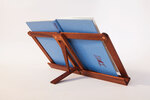We may receive a commission when you use our affiliate links. However, this does not impact our recommendations.

Bill Robertson’s “Architect’s office #1.” It’s the work space of my dreams, except that it’s too small for me. Everything in this office built to tiny scale functions as would its full-scale counterpart: The seats of the stools can be raised or lowered, the drafting tables tilt…you get the picture.
Bill Robertson builds miniatures, from tables, chairs, cake stands, and stoves to complete houses, as well as the tools with which to build these things, most often to 1/12 scale. All are meticulously researched and exquisitely crafted with fully functioning mechanical parts.
Let that sink in a moment while pondering the toolbox below, with Robertson’s fingers and a pencil tip for scale.

Image copied from ted.com
Given how little space Robertson’s creations require, you might imagine his workshop to be sized proportionately, albeit with some allowance for the full-scale craftsman who has to work there. As it happens, Bill’s shop, located in the basement of his 1914 home in Kansas City, is surprisingly large: 600 square feet.
If you’ve seen Robertson’s work and heard him speak, it will not come as a surprise that his work space is arranged with as much consideration for his working pleasure as meticulous labor; hence the apparently larger-than-necessary space. You could say Robertson’s shop is a vertical take on that classic ‘80s haircut, the mullet: in this case, it’s business on the bottom, party on top. Concern for privacy prevents me from sharing images of the space beyond the vignettes included here (I know, big groan of disappointment), but I hope the description and images that follow will inspire you to look up Robertson’s work and learn more about this mad genius of miniatures.

Robertson holds a 19th-century watchmaker’s center divider with a bone handle.
Robertson had the floor dug out deeper and covered the new concrete with antique parquet. No, this is not your typical basement floor. Nor is this your typical maker.
A variety of work-surfaces line the edges of the bench room. Beneath the bench tops Robertson stores tools and machines, many of his own making. Some drawers hold abandoned projects. Most of us have rooms or attics stuffed with half-built desks and wall shelves from project article process shoots, blanket chests that screeched to a halt when contracts were canceled, and the odd built-in that ended up an inch too wide. “I love miniatures,” says Robertson. “You can put them in a drawer and forget about them.”

Tiny dovetails made my head spin.
Above the work-surfaces, it’s all about fun. The walls are hung with artwork and collections of antique tools, “because, yes, it’s a work environment, but I want to look up and see beautiful things, not see work.” For example, he has dozens of 18th-century engravings of workshops, most of them French. Among his collections of tools are assorted dividers, some of them hundreds of years old, and a dazzling variety of hacksaws.
Another section of the workshop is devoted to machines: lathes, milling machines, die filers for making tiny router cutters, and so on.

In the machine area. This does not resemble my lathe.
While most of us store lumber in racks, Robertson stores his in drawers built into the risers of the basement stairway that run on lawnmower wheels at the back; he compares them to hand-trucks. This leaves more room for stuff he wants to look at.

Lumber storage in risers


A tiny urn turned on the lathe, the design taken from an antique illustrated in a book

Full picture for scale. Check out the parquet. In the background you can glimpse the painted basement wall with framed prints.

A couple of planes. Small, compared to most of those in my shop, but compared to most of Bill’s work, they’re downright gargantuan.
Ogle at more of Robertson’s creations and learn more about him by watching his TED talk.
– Nancy Hiller
Here are some supplies and tools we find essential in our everyday work around the shop. We may receive a commission from sales referred by our links; however, we have carefully selected these products for their usefulness and quality.








